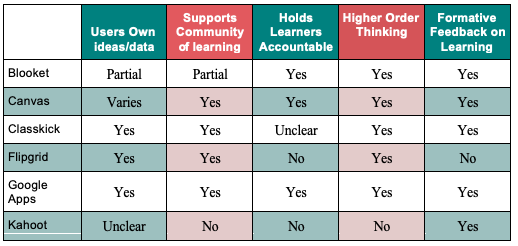Do the most commonly recommended k-12 student learning focused technology tools include built in capabilities that promote responsible digital use and citizenship?
“The crisis caused by COVID-19 has facilitated the creation of alternative and varied environments to search for information, consume content, and create and share content, as well as other factors that enable greater communication, socialization and networking for collaborative work” (Rodríguez-Moreno, 2021). This rapid search for digital education tools has meant a greater need for student-learning technology that has capabilities built into the program that encourage students to positively contribute to and responsibly participate in the digital world. To meet this need, educators must carefully choose the technology they use.
Criteria for adopting technology for use in classrooms includes several factors that specifically address digital citizenship. Western University’s Rubric for E-Learning Tool Evaluation lists several examples that are common to multiple institutions (Antsey, 2018):
- “Users maintain ownership and copyright of their intellectual property/data
- The tool has the capacity to support a community of learning
- The tool provides technical solutions for holding learners accountable for their actions
- Use of this tool easily facilitates learners to exercise higher order thinking skills
- Through the tool learners can regularly receive formative feedback on learning” (Antsey, 2018)
The most commonly recommended tools for classroom education proved difficult to find if consideration was given to who made the recommendation. Often articles touting titles that asserted that the article was about teacher chosen tools proved to contain recommendations from consultants who were not in classrooms or a single individual. However, a small group of tools appeared on enough lists that I’ve chosen to examine them closely here for their adherence to the above criteria.
By evaluating and re-evaluating technology tools using these criteria, educators can ensure that they positively contribute to the learning environment.

Blooket
Blooket’s privacy explanation provides users minimal control of their own data, however it states that personal information will be “erased where there is no compelling reason for its continued processing” (Blooket, 2021). The game-based review app allows students to play on teams or to play individually in activities that combine strategy and content knowledge. The program allows students to choose their own nicknames, but also has a setting that auto generates nicknames, preventing poor choices from being a problem. Further, it limits student behavior by restricting access to socialization within the games or in the wider digital community. The questions are strictly multiple choice, however the games require problem-solving and planning skills. The game provides immediate feedback to students on their progress.
Canvas
Canvas is one of the most popular learning management systems available; however, it earned a “warning” status from the Common Sense Media Privacy Program for its handling of user data (Common Sense Media, 2020). As a learning management system, Canvas meets other criteria listed. Discussions support communities of learning and higher order thinking, and the grading and comment system support formative feedback on learning. Tools such as discussion moderation, preventing students from seeing other students’ work before posting, and threaded discussions support holding learners accountable for their digital behavior (Canvas, 2021).
Class Kick
Class Kick is an activity-based learning management system that is less robust than Canvas, but better geared toward primary and secondary students. It has some interesting tools that support communities of learning, such as the “Peer Helper” function, which alerts students that their classmate has asked for help so that they have the option to assist them (Class Kick, 2021). The program provides opportunities for teachers to set up activities and questions that require higher-order thinking, and to provide feedback throughout the learning process.
Flipgrid
Flipgrid earned a passing grade from the Common Sense Media Privacy Program for its practices regarding user data which include that educators control and own student created data rather than the app (Common Sense Media, 2020). The program allows students to record video responses to questions, which results in an both an open-ended response system that encourages higher order thinking, and a community of learners who watch and respond to each others’ videos. The peer response component and teacher feedback allows for formative feedback but no feedback comes from the app. Teachers have the option to moderate both videos and comments to ensure that they preview the content before showing it to students. It appears that accountability for misuse must occur off the app, however.
Google Education Suite
Google classroom earned a passing score from the Common Sense Media Privacy program for its practices regarding user data (Common Sense Media, 2020). The education suite provides multiple tools for supporting a community of learners, engaging in higher order thinking, and providing formative feedback. There are varying options for holding learners accountable for their behavior while using the programs. For example, educators can mute students who misuse the posting and chat functions, and the document history allows educators to check student actions within documents.
Kahoot
The review game Kahoot provided unclear information regarding user data and materials, but scored well in providing formative feedback on learning. The multiple-choice game program does little within the app to support a community of learning, or engage higher level thinking. Anecdotally, holding synchronous games has been helpful for building community in my remote classes (but the conversations students have during games occurs using a separate stand-alone video conferencing platform, not Kahoot).
Deeper problems arise regarding the ways in which Kahoot is vulnerable to poor digital behavior, which makes holding users accountable with the program’s built-in capabilities a near impossibility. At its most basic, students generate their own nicknames, which can be offensive; but, teachers can delete nicknames or opt for auto-generated nicknames. The program is particularly vulnerable because teachers generate a code to invite students to participate, which allows students to share their code with others outside of the class or to bots designed to spam or crash the game (Krishna, 2018). Further, there are multiple videos and websites purporting to show how to hack the game to get the correct answer all or most of the time, most websites contain malware and cannot be safely linked to this post.
Resources
6 essential EdTech tools for teachers in 2021. (2021, January 19). Educational Technology and Mobile Learning. https://www.educatorstechnology.com/2021/01/6-essential-edtech-tools-for-teachers.html
Anstey, L., & Watson, G. (2018, September 10). A Rubric for Evaluating E-Learning Tools in Higher Education. EDUCAUSE. https://er.educause.edu/articles/2018/9/a-rubric-for-evaluating-e-learning-tools-in-higher-education
Blooket. (n.d.). Blooket privacy policy. Retrieved May 27, 2021, from https://www.blooket.com/privacy
Class Kick Support, I’m a Teacher. (n.d.). Class Kick Zen Desk. Retrieved May 29, 2021, from https://classkick.zendesk.com/hc/en-us/categories/360005467372-I-m-a-Teacher
Common Sense Privacy Evaluation for Canvas. (2020, January 8). Common Sense Media Privacy Program. https://privacy.commonsense.org/evaluation/canvas
Common Sense Privacy Evaluation for Google Classroom. (2020, December 20). Common Sense Privacy. https://privacy.commonsense.org/evaluation/Google-Classroom
Common Sense Privacy Standard Privacy Report for Flipgrid. (2020, December 18). Common Sense Privacy Program. https://privacy.commonsense.org/privacy-report/Flipgrid
Discussions: Canvas Demo. (n.d.). Canvas. Retrieved May 27, 2021, from https://bsd124.instructure.com/courses/471/pages/discussions
Eaton, M. (2021, April 22). Powerful, Lesser-Known Tech Tools for Teachers. Edutopia. https://www.edutopia.org/article/powerful-lesser-known-tech-tools-teachers
Krishna, R. (2018, September 12). Students Are Using Bots To Crash Games Of Kahoot At School. BuzzFeed News. https://www.buzzfeednews.com/article/krishrach/kahoot-quizzes-bots
Murray, J. (2019, July 24). How to evaluate tech tools you’ve never used in less than seven minutes. National Education Association. https://www.nea.org/advocating-for-change/new-from-nea/how-evaluate-tech-tools-youve-never-used-less-seven-minutes
Rodríguez-Moreno, J., Ortiz-Colón, A. M., et al. (2021). The Influence of Digital Tools and Social Networks on the Digital Competence of University Students during COVID-19 Pandemic. International Journal of Environmental Research and Public Health, 18(6), 2835. https://www.mdpi.com/1660-4601/18/6/2835/htm

Hi Deanna, thank you for putting this list together. I have not previously heard of Blooket nor Classkick but thanks to your post, I get to check them out. I also found the Western University’s Rubric for E-Learning Tool Evaluation to be a handy reference for when I’m evaluating my next EdTech tool. I’m always hunting for exciting tools to enhance students’ learning experience!
Hi Deanna, great job in comparing all these tools we use daily in our class. Your chart is very helpful to understand how each of the tool meeting the criteria. One interesting thing to me is Kahoot is relative rated low compared to the others but it is the most popular one for students in my class. I would like to learn more about how tools positively contribute to the learning environment in students perspective.
Vivian, have you tried Blooket? It’s also free, and appeals to students who like Kahoot. I moved over to Blooket when a coworker started having problems with kids spamming her Kahoots.
I’ve talked about Western University’s rubric at work – it’s a great starter for us. I find that a lot of the information in terms of what a tool can or cannot do comes down to the contract/terms of service and what was negotiated, for example, we negotiated to not have our data used for research purposes with a different vendor.
I also find the Common Sense Media page about Canvas to be interesting too, it seems like that review is of the free to use one, and that a lot of the points wouldn’t apply the in the same way for institution specific instance of Canvas. That said, It’s really interesting to use the evaluation as a comparison for the criteria I use to look at tools. Great food for thought!